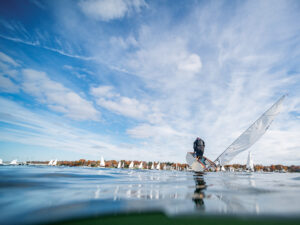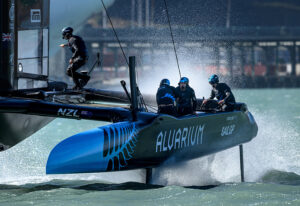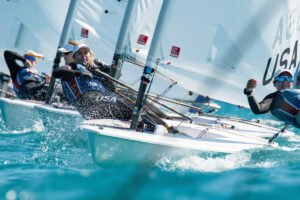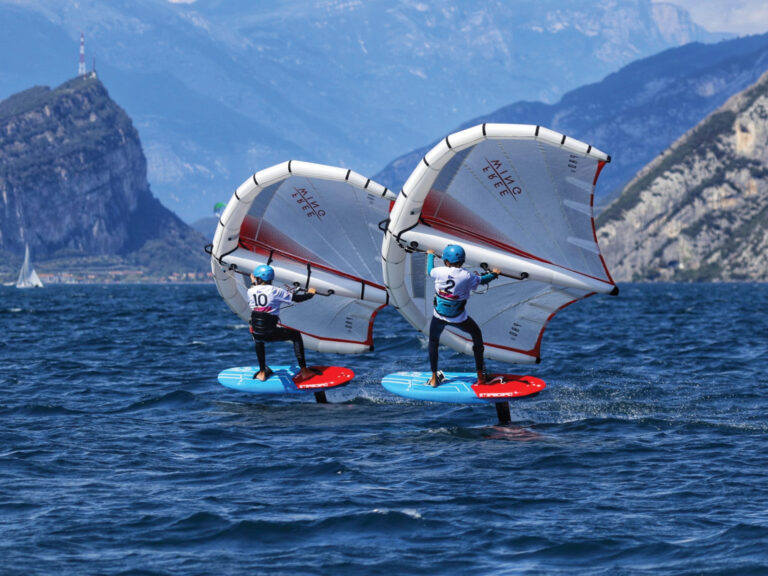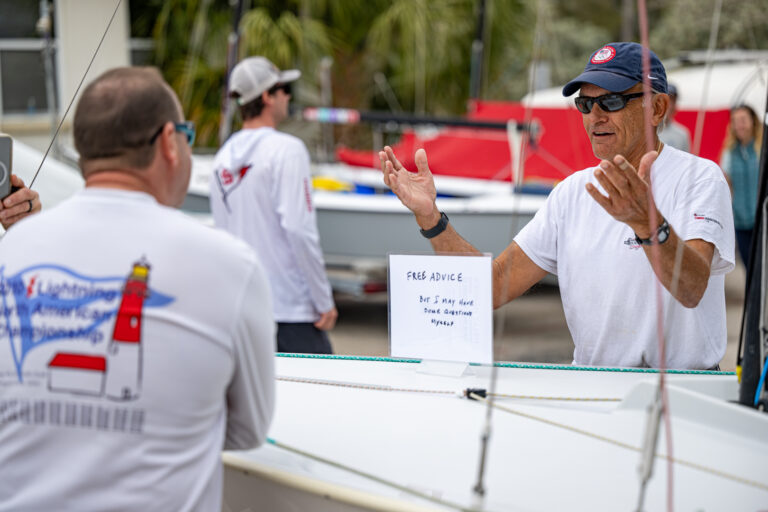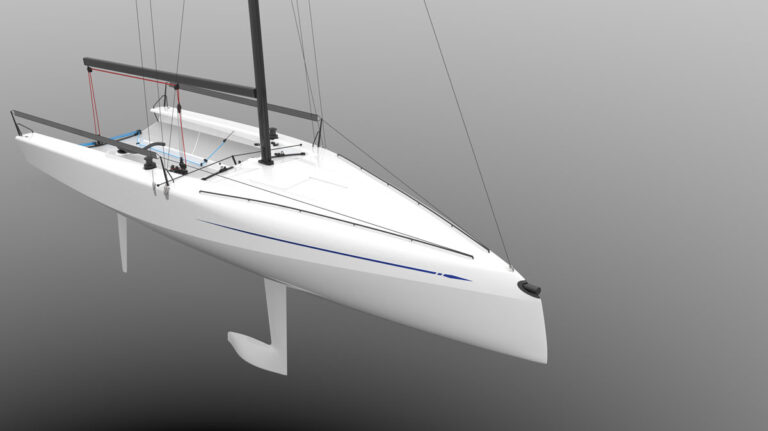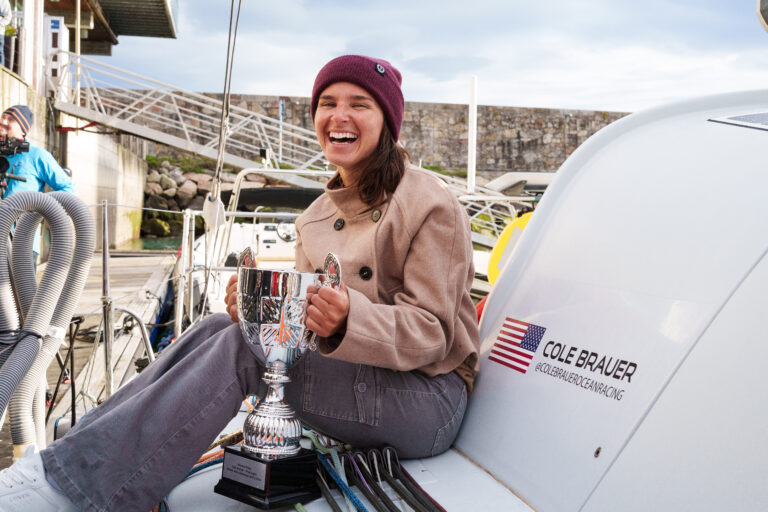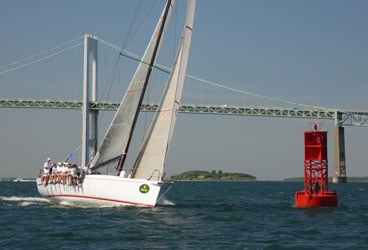
FBBermudaThree368
Stop the Presses!!
At 3:30 Thursday afternoon, I received a phone call from Privateer’s boat captain, Ian Henderson, who said simply two words: “We won.” I handled this coolly, shouting “What?” into the phone, and he replied that the race committee had called with apologies, saying that they’d made an error in our finishing time (something that I, as the navigator should have picked up on earlier), and that we’d actially beaten the Volvo 70 il mostro by 22 minutes, not lost to them by 35. So yippee-ki-yay for the crew of Privateer, who endured 88h:43m:2s of upwind pain, and left Bermuda feeling OK, but not great. Ron O’Hanley, Privateer’s owner, is about to get the good news: that in his first Bermuda Race he nailed a first against two of the fastest boats on the planet. I’m grinning ear-to-ear right now, and so will the rest of the crew once the news spreads. Good job boys! http://www.bermudaraceadmin.com/2008results/ORR16.html
Thirty-five Minutes
My apologies for leaving the story of Privateer’s Bermuda Race hanging. The computer I use as backup navigation computer in case the boat’s computer fails had a tough trip, too, and didn’t want to boot up once we got to Bermuda. I’m posting this from home, after a day of travel, and a little more than 24 hours in Bermuda, 24 hours in which we did what Bermuda racers do once they make it to the dock: eat, drink, and be merry. We did all three things well, woke up this morning, and headed for the airport. I’ll cut to the chase. We ended up in second place in the Open Division, correcting out 3 hours ahead of Alex Jackson’s 100-foot Speedboat, beat Gryphon Solo, skippered by Joe Harris, boat-for-boat, and lost to Ken Read and his Volvo 70 by 35 minutes, corrected time. Thirty-five minutes over 635 miles. Thirty-five minutes that we can firmly pinpoint when and where we lost the race.
At 1:15 Tuesday morning, 49 miles away from Kitchen Shoal, we snagged a large warp of line with three floats attached to . . . nothing. Just a random piece of flotsam that we nailed dead square, and wrapped around our saildrive unit. The crew on deck noticed two things, a huge reduction in speed and a rapping noise against the hull. Once the cause of both was established there was little hesitation. The headsail came down, the main was released, the boat was canted hard over, and one of the crew jumped into the water (about 13,000 feet deep) with a knife and tried to saw the line off the saildrive. After a few minutes, he was tired and another crewmember stepped forward, jumped in, and finished the job. From the moment we snagged the line, to the moment we started sailing fast again, easily took 35 minutes. We wouldn’t find out about how close we were until hours after we finished early Tuesday morning how close we came to nailing first place, which is just as well, as it didn’t interfere with our first few hours of post-arrival celebration when we got to the Royal Bermuda YC.
Rewind to my last report, and you’ll remember that we made the painful decision to tack across on port in order to get West. We did that again late Monday afternoon, in order to stay between the bulk of the fleet and the finish. At 8 p.m.,about 115 miles from Bermuda, we tacked back on starboard, and headed for Kitchen Shoal. We nailed that layline, thanks to a steady breeze direction and speed, and some good driving. About ten miles from Kitchen Shoal, we saw the 68-foot Donnybrook on the opposite tack. They tacked on our layline and followed us in to the finish. We tacked two more times, once to get to the finish line, and another tack to cross it and head off to clear the line per the sailing instructions. Shortly after finishing, I called the Race Committee, again per the SIs, and a pleasant woman’s voice with an Australian accent welcomed us to Bermuda and said merrily: “Welcome to Bermuda, we’ll see you at the club, Privateer.” I was tired, excited, and not really paying attention, but I did manage a polite “thanks for a great race,” and thought nothing more of the warm welcome.
After the two-hour journey from the finish to the RBYC, in which we cleaned up the boat, collected our personal belongings, and congratulated one another on what we knew, even at that point, was a well-sailed race, we got to the docks. A harried, but well-prepared and competent dockmaster put us in a decent spot, and we started counting masts/ to see how many boats had arrived before us. We counted 19 rigs, which was confirmed by the unofficial finish sheet we saw at the club a few minutes later. The ineup at the dock was impressive, but there were a couple of surprises there, too. Rambler, il mostro, Numbers, Bella Mente, Blue Yankee, Moneypenny, in short, all the big, fast boats, were tied up and squared away. But so was Clay Deutsch’s Swan 68 Chippewa, and the Santa Cruz 52 Bombardino, skippered by James Sykes, and Lerry Huntington’s 50-footer Snow Lion. Obviously, 635 miles of upwind sailing were perfect conditions for those three boats.
We tied up, turned in our paperwork and our tracking unit, grabbed all the delivery gear and our crew bags from the containers that were shipped from Newport to Bermuda, and hit the bar at the RBYC for a few well-earned cold beverages. It doesn’t mater what time it is when you finish a Bermuda Race, because after 635 miles of sailing, “normal” time doesn’t exist any more, so it’s perfectly acceptable to be standing around swilling beer and Dark and Stormies at eleven o’clock in the morning. After an hour or so, though, it’s time to head for the hotel and get cleaned up. As good as the beer and the rum drinks are, that first shower is even better. Mark Van Note, Skipper Helme, and I shared a room at the Hamilton Princess Hotel, and after taking our showers and eating some cheeseburgers courtesy of room service, we all took a little nap before dinner. Mistake. Mark and I overslept and were half an hour late for dinner, which was at one of Bermuda’s hallmark pub dining spots, the Hog Penny. It was there that Mark and I found out we’d missed first place by 35 minutes. We were still dopey from our naps, but that snapped us out of our torpor. Thirty-five minutes that we could have made up anywhere on the racecourse, but of course, it all really came down to that that damned chunk of line.
Still, we beat the biggest, fastest boat in the race. We finished in the top ten percent of the fleet, boat-for-boat, and we’d sailed a boat designed to fly off the wind for 635 miles dead upwind, and did well. While it would have been nice to be at the top of the podium, second place ain’t bad, was the crew’s consensus, and is mine as well. There were points in that race where I didn’t think we’d finish in any kind of decent placing, so second place, even in our tiny class of four canting keelers, is OK by me.
This was my tenth Bermuda Race, and it won’t be my last. Several of Privateer’s crew were doing there first, and I’m sure it won’t be there last, either. There’s something about that patch of water, and the final destination, that’s highly addictive. Oh, and that voice from the finish line. Well, it turned out to be the voice of one of our crew’s girlfriends, who’d tracked our position, had a good idea of when we’d finish, and made her way out to the lighthouse in the early hours of the morning to take pictures. She asked to the race committee members on duty if Privateer had finished yet, and they told her we’d checked in from five miles out, and asked her if she would like to watch the finish from the tower and welcome the boat to Bermuda.
June 23, 2008
Aboard Privateer, 34 25 North, 065 50 West
It’s been a tortuous 24 hours, but that will soon be forgotten as we’re now headed straight for Kitchen Shoal at 8.8 knots in a 15-knot breeze that has us hard on the wind. We’re showing 134 miles to go to the Kitchen Shoal buoy, and if the forecast and wind direction holds–well, I’m not going to write down, or even speak aloud about an estimated time of arrival. We’ve had enough tough sailing without me tossing any bad luck into the mix.
We found ourselves well east of the rhumbline this morning, thanks to a heading breeze, so at around 0930, we took a painful tack to get some westing back. After 42 miles of feeling as if we were sailing away from the islands, we tacked back. We’d made some progress down the track toward Bermuda, but it sure didn’t feel like it.
Speedboat, the Juan-K-designed 98-footer finished this morning, with an elapsed time of 64h:42m56s, which leaves them owing us slightly over 27h:41m.Needless to say, with 127 miles left to sail, we’re hoping the breeze stays up and we’re able to keep heading in the right direction. It’s too bad the four canting-keel boats were all forced into the Open Class, as it’s hard for a 98-foot boat to protect itself from a 50-foot canter coming in with breeze many, many hours later. One of the neat things about IRC is that it rates canters against fixeed-keel boats well, so we should be racing against boats in our rating band, rather than a design band. Maybe in 2010.
This has been an upwind race, and the overall results will show it. Boats that go well upwind, such as Larry Huntington’s 50-foot Snow Lion, will probably beat us boat-for-boat, as will boats with greater waterline length. So what we’ve tried to maintain our focus on is simply the other three boats in our class. When we know what time il mostro finishes, we’ll have another hard target to aim for. We also have to protect what, at the 0800 schedule showed as us ahead of Gryphon Solo. This is the first Bermuda Race that Privateer’s owner, Ron O’Hanley, has sailed in this boat, so it would be nice to score well in our class, small as it is.
This particular Bermuda Race has been one of the hardest I’ve ever navigated. I’ve been alternately happy, distressed, worried, ecstatic, and terrified as each postion report, wind change, and current has effected us. My co-navigator, Skip Helme, and I have been bouncing ideas off each other the entire race, trying to put the boat in the right places on the racecourse. It’s way too early for a post-mortem, but I would have been happier had we tried to stay West earlier in the race. It was tough to call that tack this morning, and although they hid it well, I could tell some of the crew weren’t too happy with the call. No matter how it ends, I’m pretty sure we’ll all still be speaking after the race, especially after a few cold ones. Mmmmmm, cold ones.
One last night at sea (please don’t punish me, Poseidon), is most likely in store for the crew of Privateer. We’re all looking forward to hot showers, clean clothes, crisp, clean sheets, soft pillows, and did I mention cold beer? Of course, the navigator’s job isn’t done once his or her boat crosses the finish line. If you finish at night, it’s very easy to screw up even after finishing, as you can be protested by the race committee if you don’t a) actually cross the line (it’s marked by small buoys that are clearly stated in the Sailing Instructions as being “in the vicinity” of the actual finish, and b) you have to turn to seaward after you cross to avoid the reefs just off the starboard end of the line. Then it’s a couple of hours of motoring through some tricky channels surrounded by hard bits to get the boat safely from the line off St. Davids head to the dock at the Royal Bermuda YC. Many a navigator has ended the race well, but done poorly on the follow through, so the post-finish celebration is best held off until the lines are safely tied to the dock.
[Editor’s note:] The first boats have crossed the line. While the 2008 race featured similar conditions to that of 2006-predominantly light winds with some upwind work toward the end-there were no surprises with the line honors winners like in 2006, when the 66-foot Bella Mente bested the 100-foot Maximus. Alex Jackson’s 98-foot Juan Kouyoumdjian-designed Speedboat was the first across the finish line at 9:12 a.m. local time in Bermuda, taking line honors in the four-boat Open division. The canting keel rocket missed the Open-division record by a good margin, finishing in 64 hours 42 minutes and 56 seconds, more than 16 hours slower than Morning Glory’s time in 2004. George David’s 90-foot Rambler was the first boat from the Gibbs Hill division to cross the line, doing so just after noon for an elapsed time of 69hrs 5mins 27secs. For more on the finishers, as they come in, log on to www.BermudaRace.com.
June 22, 2008
Aboard Privateer, 37 01 North, 67 01 West.
It’s really hard to type on port tack, as the nav station is on the port side of the boat. Especially when you’re bashing upwind at 9.6 knots in a current-induced chop. I’m not complaining; were through the Stream, and that’s a good thing. It wasn’t a rough scene in the Stream, but the current was strong, the wind was light, and we were getting taken to places we didn’t want to go.
I just took a look over boat captain Ian Henderson’s shoulder as he was inspecting the canting-keel mechanism. It’s exciting to sal a boat with a hole in its bottom.There’s a large box with a large, clear hatch (basically a square foredeck hatch) in the center of the boat that contains the head of the keel, the single hydraulic ram that cants it, and some large bits of metal frameowrk that carry the immense load. Seawater flows over and around the head of the keel constantly, and when we’re really heeled over, the water sucks out of the space between the keel and the flange that surrounds it. It sounds like a high-powered toilet flushing. Without really thinking about it (well, me, anyway), we’ve placed an awful lot of faith in engineers, hydraulics mechanics, and boatbuilders when sailing a boat like this. But everything seems to be holding together nicely.
We’ve beeen headed, so I just called for a tack. Purely a tactical decision, I assure you, but it sure is easier to type now. According to the forecasts, and what we’re seeing, it looks as though we’ll be tacking upwind to Bermuda. Yuck. Our routing software is telling us this tack is favored for the next 31 hours, but that will change, I’m sure.
Yesterday and last night were frustrating, especially as I started plotting positions of the other boats in our class and the fleet overall. We’ve had some work to do to claw our way back up the leader board, and have more clawing to do. The boats that rate closely to us mostly have longer waterline lengths, and these upwind conditions suit them well. We’re hoping–probably in vain–that we’ll have a few miles of sailing in the conditions this boat was made for; reaching or running, but as I mentioned earlier in this missive, that’s probably not going to happen.
As I write this, we’re 293 miles from Bermuda’s Kitchen Shoal. Speedboat, the biggest boat in our 4-boat class, was 191 miles from Bermuda at ten o’clock this morning, making 10 knots. They’ll get there well before we do, of course, but owe us an amazing amount of time. While they’re knocking back a few Dark and Stormies at the Royal Bermuda YC, we’ll be doing our best to keep them looking over their shoulders, even as they relax after their fast passage.
Time for another check on the positions of the other boats in our class, and the fleet, then maybe 40 winks.
June 21, 2008
From Privateer, 38 degrees 48 minutes north, 69 degrees 46 minutes west, and 170 miles down the road to Bermuda.
It’s been a pretty uneventful race so far. We’re well off the Continental Shelf, making 7.3 kinots over the bottom, and as far as I can tell from the latest GRIB file, well into the warm eddy that everyone else in the fleet headed for as soon as they left Newport. The latest plot shows us at 509 miles from Bermuda, and about 80 miles behind the Volvo 70 il mostro. Our main competition, the Open 50 Gryphon Solo, is 11 miles closer to Bermuda, but they owe us some time, so we’re probably ok on time with them.
After 24 hours of racing, the crew has settled into the offshore routine well. That’s been helped a lot by the conditions, which have been benign. There’s enough breeze to push us along nicely, and although we haven’t yet seen the conditions we do best in (reaching in over 15 knots of wind), we feel as though we’re well positioned for our crossing of the Stream. I’m a little disappointed we’re not seeing more current with us, but I’ll take what positive push we have. According to one GRIB, we may be located a bit too far left to get the meat of the current, but as I look at the positions of other boats, there are many otheres who are even further left. The big boys seem to have chosen to stay more east, and may have nailed the current perfectly according to one GRIB I’ve seen.
We’ve seen breeze from 15 knots down to two, and boatspeeds from 12 knots down to three. Judging from the position reports I’ve seen, most everyone went through some light patches early this morning. As any navigator is during this race, I’m perpetually fearful that someone else has found a better way to go and is soundly thrashing us, but I keep reminding myself there’s a lot of racecourse left, and more breeze promised.
Privateer is an exceptionally well set up boat for offshore racing. There are plenty of bunks, and even I’ve been able to snatch some sleep every few hours, or at least until someone needs some information or some decision about course changes have to be made or discussed.
The weather has been beautiful; the foulies are all put away (or strewn about, depending upon the crewmember), and shorts and sunscreen are the uniform of the day. The water temperature is in the mid 70s, the sun is shining, but the breeze is cool enough tp provide some relief. The nav station is providing my usual dose of SPF 1,000,000, guaranteed to see me as pale in Bermuda as I was when we left the dock in Newport.
The start was exciting. We were the last class to go, and since we started with two of the biggest, baddest boats in the fleet, il mostro and Speedboat, soon after the start we were passed by every single powerboat in the spectaor fleet, rushing to catch up with the two speedsters. The waves and wash were a major pain in the ass to sail through, and it was hard to hear anyone talking over the buzzing of the three helicopters flying overhead. Soon enough we were out of the washing machine, and headed offshore, and bliss began. I really hate the last few hours before Bermuda Race starts, I just want to get on the boat and get going, so waiting until 3:30 to start yesterday was pure agony. Once we got out here though, I began to enjoy what I anticipate every two years–the thrill of sending a boat down a racecourse toward Bermuda.
I’ll check in again tomorrow afternoon. Until then, feel free to armchair quarterback our route so far by checking in with the www.bermudarace.com, and going to iBoat.
June 18, 2008
Making Plans, Packing Bags
The Newport Bermuda Race starts in two days. The crew of Privateer is making their final preparations, which include things like getting party clothes in bags and into the shipping container that leaves Newport for Bermuda on Thursday morning. We’ll be polishing off our Honey-do lists at home, packing the small amount of personal gear we’ll each bring on the boat, and making sure all the tasks that need to be finished at our various jobs are done so we can leave with clear consciences.
Packing: As the navigator, I have slightly more latitude when it comes to carrying gear aboard. I’ll have my personal laptop, which is loaded with Nobeltec Max Pro, the latest version of Expedition, charts for the race, and all the Sailing Instructions. I’ll also be carrying my Garmin Colorado 4000C handheld GPS, which I just loaded with g2 Vision BlueCharts of Bermuda and the entire East Coast of the U.S. I’ll also have paper copies of the SIs, paper charts, a logbook, a few pencils and pens, weather forecasts, Gulf Stream data, and a bunch of Advil and Tums; navigator necessities.
For clothing, I’m going to go as light as possible, as it looks like a relatively tame race weather-wise. From the top: a fuzzy hat for the first night, along with cold-weather gloves. One ball cap, from the 2002 Bermuda Race, which was a rough one, so I’m hoping it serves as a talisman. For base layer, it’s Patagonia Silkweight boxers (2 pairs), 1 Silkweight short-sleeve T-shirt, 2 Helly-Hansen long-sleeve, wicking shirts, and one pair of socks. For mid-layer I’ll bring my trusty Musto salopettes, which are 6 years old, but still the most comfortable and durable mid layer gear I’ve ever owned. As one friend described his pair: “Putting these on is like getting into a comfy sleeping bag.” My mid-layer jacket will be Gill’s Convert jacket, and I’ll bring one of the new Puma vests. For foul-weather gear, Musto MPX bibs, and Helly-Hansen’s Point, a breathable, waterproof jacket. For boots, as part of a boot-test story I’ll be writing for the September issue of SW, I’ll be wearing Slam’s Code 4 boots. I’ll also bring one pair of Camet shorts, a toothbrush, and a small tube of toothpaste. That’s it. We’ll all bring our gear bags down to the boat on Thursday, so boat captain Ian Henderson can weigh it, chuck what he feels is overkill, and stow it.
Thursday’s a busy day for meetings. We’ve got a Commander’s Weather personal briefing at 4:15, the Skipper’s meeting at 5, a personal Gulf Stream briefing with Jenifer and Dane Clark at 7, and a crew dinner at 7:30. The crew dinner should be fun, as Privateer’s owner, Ron O’Hanley, has been kind enough to invite wives and significant others along.
On Friday, there’s weather and Gulf Stream briefings en masse, with both Commander’s and the Clarks, then it’s down to the boat. As the first gun won’t sound until 1 p.m., and we’re in the Open Class, which will be the last start of about 20 (with ten minutes between each start), we’ll have plenty of time to do last-minute stowing, calibrations, and good-byes. We’ll probably eat lunch on the dock, then head out around 1 o’clock or so.
The weather looks a tad light for the first day or so, with SSW winds for the start. A warm eddy on top of the Stream is still slightly to the west of Rhumbline, so that’s where the bulk of the fleet will probably head off the starting line. As is usual this time of year, the weather off the East Coast is a mixture of large high-pressure zones and a few weak troughs of low pressure. The key will be to get south quickly, before the wind starts to die on the coast late Friday and all day Saturday. The faster boats should have no problem legging out and getting ahead of one trough, which should keep them in a 10-to-15-knot SW breeze. The slower boats may have a struggle getting out to the warm eddy quickly enough to stay in the breeze. For those boats that haven’t reached the Stream by Sunday, it may get very rough, as a low is expected to develop just south of the Stream by then.
I’ll make one final land-based report in the next day or so, and will then be filing reports from Privateer during the course of the race and once we get to Bermuda. I’ll be sending pictures as well, and a daily position report, although www.bermudarace.com will be featuring iBoat boat tracking, which receives positions from the transponders placed on each boat, delays the information 4 hours, then posts every boat’s position. It’s a great way to follow the race.
June 11, 2008
It’s Crunch Time in Newport
It’s only 9 days until Bermuda Race starts, and 2 until the Onion Patch series, the first races of which are known as the New York Yacht Club Annual Regatta presented by Rolex. [The second part of the Onion patch Series is Bermuda Race, the third is the Anniversary Regatta at the Royal Bermuda YC] There are 110 boats registered in the 154th Annual Regatta, and 224 registered in the Bermuda Race. Since the annual regatta starts off with a petite distance race around R.I.’s Narragansett Bay, (which is not part of the Onion Patch Series) and ends with two days of buoy racing (which is), it’s a great practice session for the Bermuda Race teams.
The 154th Annual Regatta will also serve as a first introduction for many to some of the hottest new monohulls to hit the water this year. Hap Fauth’s Bella Mente, a Reichel/Pugh 69, Speedboat, Alex Jackson’s Juan Kouyoumdjian-designed 99-foot canting keeler, Jim Swartz’s STP 65 Moneypenny, and Dan Meyers’ Judel/Vrolich 66 Numbers, will be some of the newcomers. They’ll be joined by some of the most heavily and successfully campaigned big boats in the world: George David’s R/P 90 Rambler, Bob and Farley Towse’s R/P Blue Yankee, the winner of the Block Island Race in late May (another tune-up for Bermuda), the STP 65 Rosebud, skippered by Roger Sturgeon. The IRC 0 and IRC Super Zero classes will be a lot of fun to see race.
Another group well worth watching will be the rapidly growing class of NYYC 42s, 14 of which will be racing in this weekend’s series, 6 of which will be heading for Bermuda. It will be the first big offshore outing for this class, and it will be interesting to see how well they stack up against their big sisters, the Swan 45s, and the other 40-somethings entered in the event.
The Gulf Stream, which has been a complicated puzzle for those of us who’ll be spending most of the race staring at screens in our various nav stations, seems to have settled in a bit. Not to go into great detail, but a warm eddy just off the Continental Shelf is smack on the rhumbline to Bermuda, which will impact early decision making, as it is showing currents in the 2-to-4-knot range. This warm eddy may well merge with the main bulk of the Stream before the race. As Gulf Stream guru Jenifer Clark says “In general, Gulf Stream current speeds are estimated at 2-4 kts. The maximum current in the Gulf Stream is varies from 3-30 miles seaward of the North wall or Western Boundary. However, it is usually located within 5-10 miles from the north wall.”
South of the Stream a couple of cold eddies will influence many decisions, especially those made by navigators on smaller boats, which will spend more time in or out of their influence. My guess now is that the faster boats will make current plays in the warm eddie and in the Stream itself, then head down the Rhumb, as the cold eddie currents look tobe in the 1-to-2 knot range.
Of course all this planning will fly right out the window if the Stream and its associated eddies change radically in the next few days, and as we start seeing reliable wind forecasts at the beginning of next week.
Our boat captain, Ian henderson, has been feverishly preparing Privateer for both the Annual Regatta and the Bermuda Race. A slew of electronics problems discovered during the Block Island Race have been solved, and a brand-new KVH satcom antenna dome has been mounted and wired into the system. This will allow us to get weather, track the positions of other boats in our class, and allow me to once again share some real-time tales from the race as we make our way toward Bermuda next week.
May, 2008
According to the Bermuda Race website, as I write this, there are 39d:3h:1m until the 220 entries of the 2008 version of the Newport Bermuda Race hit the starting line and start the 635-mile trek to the Onion Patch.
Those of us involved with the navigational and tactical aspects of the race have been preparing for some time now. I started looking at Jenifer Clark’s excellent Gulf Stream images about two months ago and received my first Stream forecast from Commander’s Weather last Monday.
Right now, things look pretty straightforward, navigation-wise. As Commander’s says, there’s a “large northward meander located just upstream of the Newport-Bermuda rhumbline,” which is surrounding a counter-clockwise rotating cold eddy. This, according to Commander’s, and any sane navigator, means that if we were leaving today, a rhumbline course would be the sanest choice. Of course, a lot can change in 39 days, but keeping an eye on the meander and the eddy is a good way to get a feel for what will be happening the day we leave.
Skip Helme, of Brewer Street Boatworks in Newport, R.I., and I will be sharing navigation duties aboard Ron O’Hanley’s Cookson 50 Privateer, a canting-keeler sailing in the 4-boat Open Class. As I discovered at this year’s St. Maarten Heineken Regatta, sailing a Cookson 50 isn’t the same as sailing most monohulls. In breezes between 25 and 35 knots in St. Maarten, we were seeing boatspeeds in the 20s off the breeze, and things happened quickly. This will be especially true if this year’s Bermuda Race is like the other nine I’ve sailed, where, for the most part, the course is sailed mostly off the breeze. There are exceptions, of course, but I know what I’m hoping for. This means tactical decisions on the course have to be made quickly, so I’m glad I’ll be sharing the navigational duties with Skip, who’s sailed as many, if not more Bermuda races than I have.
Over the years I’ve fine-tuned my personal gear selection for this race, and even this far out, I’ve collected all the gear I’ll be using. For safety gear I’ll be using one of Spinlock‘s first-generation Deckware Deckvests, which, although I’ve never had to use it in anger, fits comfortably enough to wear all the time. As the Bermuda Race rules require that crew wear their PFDs at the start, and from dusk ’til dawn, that’s important. I’ve replaced the auto-inflater and the CO2 cartridge, and made sure the vest is packed properly. For the first time, I’m changing out my old tether, which has two straps and a shackle on the inboard end, for one of Spinlock’s new cow-hitch tethers.
I’m attaching a new piece of gear to my Deckvest, an ACR ResQFix PLB, which is a personal EPIRB with an internal GPS receiver. It’s small enough to have affixed to the Deckvest permanently, and it’s a piece of gear I’ve always wanted to have with me on offshore races.
It’s my intention to post live stories from the boat during both the Block Island Race, a 185-mile petite distance race from Stamford, Ct., out Long Island Sound, around Block Island, and back down the Sound to Stamford, and during the Bermuda Race. I’ll also be checking in prior to both races as more Gulf Stream forecasts come in, and about some other new gear we’ll be testing aboard Privateer.

